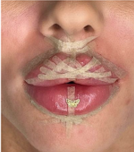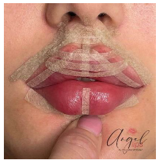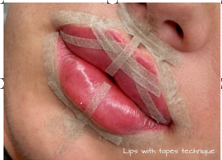In brief
- A recent trade mark decision at the UK Intellectual Property Office (UKIPO) has highlighted the difficulty in protecting a tape technique to enhance lips.
- The beauty industry thrives on innovation and creativity, yet the techniques themselves - the methods used to apply beauty products or achieve aesthetic results - remain largely unprotectable under traditional intellectual property legal frameworks.
- However, there are a number of strategies that beauty professionals can deploy to ensure they have effective protections in place.
The fundamental problem: techniques are abstract methods
IP rights provide businesses with protection for their creativity and innovation. This protection brings crucial market advantages by establishing legal barriers against competitors, allowing them to continue investing in research and development, whilst knowing their creative assets are secure.
However, beauty techniques, such as contouring methods or hair braiding techniques, are essentially methods or processes for achieving a particular aesthetic result, they face several barriers to IP protection:
Copyright
Copyright protects against the copying of original creative expressions recorded in a tangible format, not an underlying idea. It can protect the expressive elements of visual features such as typography, graphics and overall design, e.g., advertising and marketing materials, photographs, and website content, but does not cover functional components such as processes or methods.
A contouring technique, for example, is a process; a series of steps to achieve a particular look. Whilst a video tutorial demonstrating a technique might be protected by copyright, the underlying technique shown will not be. Anyone can learn the technique and apply it themselves or create their own tutorial demonstrating the same method (provided they do not copy the language used in the original tutorial).
Patents
Patent protection protects technical innovation. The legal requirements for patent protection include novelty (the innovation must be new), non-obviousness (i.e., the innovation should be inventive), and the innovation should be capable of industrial application. In the beauty space, patents may protect original ingredient formulations, delivery systems, unique manufacturing/production processes, innovative devices and applicators, and treatment methods.
However, beauty techniques per se can face significant hurdles in meeting patentability requirements:
- Novelty and non-obviousness: Many beauty techniques will be based on trivial/non-technical variations or combinations of existing methods. A new way to apply eyeliner or create curls, whilst potentially innovative from an aesthetically creative standpoint, may not be seen as a technical innovation. A successful patent application would have to demonstrate that the technology is innovative, and incremental, obvious or non-technical modifications will not qualify for protection.
- Patentability exceptions: Another interesting facet of patent law in this space is that it is easy to run into the patentability exceptions of treatment by therapy and surgery. For example, applying suncream, acne cream etc. arguably has both cosmetic and therapeutic benefits, so one must take particular care to draft patent applications only to protect the former and not the latter.
Trade marks and passing off
Trade marks protect source identifiers - brand names, logos, product names and distinctive packaging. They tell consumers where a product comes from, not how to use it.
A beauty brand might seek to trade mark the name of a particular technique, e.g., "The XYZ Contour Method", but this only prevents others from using that specific name in commerce in a way that would cause consumer confusion. It does not prevent others from performing the same technique under a different name.
Passing off can prevent a business from misrepresenting its goods or services as those of another business. However, it has limitations as it can be difficult in some instances to demonstrate such a misrepresentation. By way of example, in a claim in the High Court, Original Beauty, who owns the House of CB brand, claimed that G4K, through its 'Oh Polly' brand, was passing off its business as a sister brand to House of CB. They claimed G4K had copied their business model, social media, marketing, packaging and presentation (including using the same locations and models for photoshoots), riding on their coat tails and deceiving customers into thinking the two brands were connected. However, there was no substantial evidence that consumers believed there was a connection between the two brands and the court held there was therefore no misrepresentation by Oh Polly that they were connected to House of CB. The court said it reached this conclusion with reluctance but that passing off was not the same as unfair competition (for which there is no unified legal construct in the UK).
Design protection
Design rights protect a product's visual appearance, not the process used to create it. They can protect how a mascara brush looks, but not how the mascara is applied.
Trade secrets/confidential information
Trade secrets protect confidential information such as formulations, manufacturing processes and business methods. They can be protected as long as they are kept confidential. However, beauty techniques present a fundamental problem: they are meant to be seen and shared.
Once a makeup artist demonstrates a technique in public or on social media, it is no longer secret. The very nature of beauty techniques requires their disclosure and demonstration, which destroys any potential trade secret protection. Businesses often implement comprehensive confidentiality programmes, including non-disclosure agreements, information security protocols and access restrictions to sensitive information, but these measures are impractical for techniques that must be visually demonstrated to be understood and applied.
Case example
As mentioned above, a recent UKIPO decision illustrated the difficulty of protecting a technique through IP rights.
An application to register the trade mark showing taped lips (see right-hand image below) was filed at the UKIPO. The opponent had taught the applicant at a lip filler masterclass, with the applicant signing an agreement not to use the opponent's trade marks without consent. The opponent opposed the application based on their earlier registered trade marks (two left-hand images below), arguing there was a likelihood of confusion and that the application was made in bad faith.
| Opponent's registered marks |
Applicant's trade mark application |
| The first earlier mark |
The Second Earlier Mark |
|
 |
 |
 |
Whilst the earlier marks were registered, the UKIPO's Appointed Person in this dispute found that the extent of protection was certain elements contained in these marks - a vertical image of a human pair of lips with pieces of tape that vent in different directions (explaining these in detail), a golden butterfly on the lip in the first mark and the logo and writing in the corner of the second mark - and not the technique or method behind creating the taped lips.
The UKIPO's Appointed Person found there was no likelihood of confusion because the common element of taped lips was descriptive and non-distinctive for beauty care services. The distinguishing features (tape placement, golden butterfly, text elements) therefore took on greater significance. Even if the opponent's marks were brought to mind by the applicant's mark, the Appointed Person held this was mere association rather than confusion.
Importantly, the Appointed Person also clarified that it is not possible to trade mark a technique as a "technique is a method of doing an activity, which in this case is the method of taping lips in a particular way. Therefore the applicant's mark does not show a 'technique' or 'method', it instead shows the end results of said method/technique". The applicant had provided evidence to demonstrate that she used a different technique to the one the opponent had demonstrated to her at the masterclass, and did not intend to register a mark that used the opponent's technique.
The Appointed Person also found that the applicant had not filed the application in bad faith as the opponent's marks had been filed after the agreement between them was entered into. Any reference to "trademarked techniques" in the agreement did not therefore cover the opponent's marks. The decision did point out that, if the applicant's mark was an image of the opponent's lip technique, or if she intended it to be, then its registration would potentially be in breach of the agreement's terms.
Implications for the beauty industry
Beauty techniques spread rapidly through social media and tutorials. This democratisation benefits consumers but can mean professionals are unable to prevent others from copying their signature techniques. Successful beauty professionals should therefore focus on building strong personal brands and superior content, and developing loyal followings based on expertise and presentation rather than exclusive ownership of methods.
Practical strategies for beauty professionals
Given the limitations on IP protection for techniques, beauty professionals should focus on the following strategies:
- Build strong trade mark protection: Register trade marks for product names, logos, slogans and distinctive packaging at the earliest stages of brand development. Whilst you cannot protect the technique, you can protect your brand identity.
- Copyright can subsist in educational content: In the UK, copyright arises automatically once the work is recorded in some way. You can therefore rely on copyright to protect tutorial videos, written guides and photographs, even if the underlying techniques are not protectable.
- Develop proprietary products: Focus on creating patentable innovations in formulations, delivery systems and applicators. If you develop a unique tool or product that enables your technique, that product may be patentable, or be protected by other forms of protection such as designs.
- Leverage first-mover advantage: Being the first to introduce and popularise a technique builds brand recognition and authority, even without legal protection. Consider monitoring competitor activity and identifying potential infringements early, which will enable swift legal responses where actual IP rights (such as in branded content) are concerned.
- Contractual restrictions: where appropriate, place appropriate contractual restrictions on the use of techniques taught in, for example, masterclasses.
- Create comprehensive brand experiences: Focus on creating a complete brand experience that goes beyond individual techniques, incorporating distinctive visual identity, customer service and community building. A robust strategy ensures long-term brand protection and profitability.